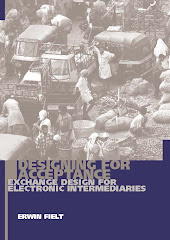With the ongoing proliferation and immersion of digital
technologies into everything we use, we often wonder how the future of the
things we use would look like. While it is not possible to predict this, it is
possible to think about it. Chance favors the prepared mind.
Thursday, October 22, 2015
The Digital Innovation of everyday things: New, Copy, Paste, Search, Save, Print, Send, etc.
Tuesday, July 14, 2015
IT Consumerization and its Effects on (Strategic) IT Managment
IT consumerization is both a major opportunity and significant challenge for organizations. However, IS research has hardly discussed the implications for IT management so far. In this paper we address this topic by empirically identifying organizational themes for IT consumerization and conceptually exploring the direct and indirect effects on the business value of IT, IT capabilities, and the IT function.
More specifically, based on two case studies, we identify eight organizational themes: consumer IT strategy, policy development and responsibilities, consideration of private life of employees, user involvement into IT-related processes, individualization, updated IT infrastructure, end user support, and data and system security.
The contributions of this paper are (1) the identification of organizational themes for IT consumerization, (2) the proposed effects on the business value of IT, IT capabilities and the IT function, and (3) combining empirical insights into IT consumerization with managerial theories in the IS discipline.
See here for more information.
Saturday, February 07, 2015
A Critical Realist Perspective of Enterprise Architecture Evolution: Conditioning and Outcomes
This paper investigates how Enterprise Architecture (EA) evolves due to emerging trends. It specifically explores how EA integrates the Service-oriented Architecture (SOA). Archer’s Morphogenetic theory is used as an analytical approach to distinguish the architectural conditions under which SOA is introduced, to study the relationships between these conditions and SOA introduction, and to reflect on EA evolution (elaborations) that then take place.
The paper focuses on reasons for why EA evolution could take place, or not and what architectural changes could happen due to SOA integration. The research builds on sound theoretical foundations to discuss EA evolution in a field that often lacks a solid theoretical groundwork. Specifically, it proposes that critical realism, using the morphogenetic theory, can provide a useful theoretical foundation to study enterprise architecture (EA) evolution. The initial results of a literature review (a-priori model) were extended using explorative interviews.
The findings of this study are threefold. First, there are five different levels of EA-SOA integration outcomes. Second, a mature EA, flexible and well-defined EA framework and comprehensive objectives of EA improve the integration outcomes. Third, the analytical separation using Archer’s theory is helpful in order to understand how these different integration outcomes are generated.
See here for more information.





